Normandy Tourism offers a unique blend of history, culture, and natural beauty, making it an ideal destination for travelers seeking an authentic European experience. SIXT.VN provides seamless travel solutions, from airport transfers to hotel bookings, ensuring a hassle-free exploration of this captivating region of France, including guidance, travel assistance, and comprehensive planning services. Consider it your gateway to unforgettable travel experiences.
1. What Makes Normandy a Popular Tourist Destination?
Normandy’s popularity as a tourist destination stems from its rich historical significance, stunning landscapes, and diverse attractions. With 620km of coastline, historical landmarks, and iconic events, Normandy welcomes tourists with open arms. According to a 2023 report by Normandie Tourisme, visitor numbers have been steadily increasing, solidifying Normandy’s position as a top destination.
Normandy boasts a unique appeal, combining historical depth with natural beauty. Here’s a detailed breakdown:
- Historical Significance: Normandy is steeped in history, most notably as the site of the D-Day landings. The D-Day beaches, such as Omaha Beach and Utah Beach, and associated museums and memorials, draw history enthusiasts from around the globe. The Caen Memorial, for instance, is a significant site that provides deep insights into World War II.
- Iconic Landmarks: Mont-Saint-Michel, a UNESCO World Heritage site, is one of the most recognizable landmarks in France, attracting millions of visitors annually. This tidal island, topped by a stunning abbey, offers breathtaking views and a fascinating history.
- Picturesque Landscapes: The region is known for its beautiful countryside, charming villages, and stunning coastline. The Alabaster Coast, with its dramatic white cliffs, is particularly striking. Areas like the Suisse Normande offer rolling hills and lush landscapes perfect for outdoor activities such as hiking and canoeing.
- Cultural Heritage: Normandy has a rich cultural heritage, evident in its architecture, cuisine, and traditions. The Bayeux Tapestry, an embroidered cloth nearly 70 meters long depicting the events leading up to the Norman conquest of England in 1066, is a must-see.
- Accessibility: Normandy is easily accessible from Paris and other major European cities, making it a convenient destination for both short breaks and longer holidays. Its proximity to Paris (just two hours away) makes it a great option for those looking to escape the city.
- Gastronomy: Normandy is renowned for its culinary delights, including creamy cheeses like Camembert, Pont-l’Évêque, and Livarot, as well as fresh seafood, cider, and Calvados (apple brandy). The region’s gastronomy is a significant draw for food lovers.
- Impressionist Art: Normandy’s stunning landscapes inspired many Impressionist artists, including Claude Monet. Monet’s house and gardens in Giverny are a major attraction, showcasing the beauty that inspired his art.
2. What are the Key Attractions and Activities in Normandy?
Normandy offers a wide array of attractions and activities, ranging from historical sites and cultural experiences to outdoor adventures and culinary delights. Key attractions include the D-Day beaches, Mont-Saint-Michel, and the Impressionist sites. Activities range from exploring medieval towns to enjoying water sports along the coast.
- D-Day Landing Beaches: The D-Day beaches are a must-visit for anyone interested in World War II history. Key sites include Omaha Beach, Utah Beach, Pointe du Hoc, and the Arromanches landing harbor. Museums and memorials along the coast provide detailed accounts of the events of June 6, 1944.
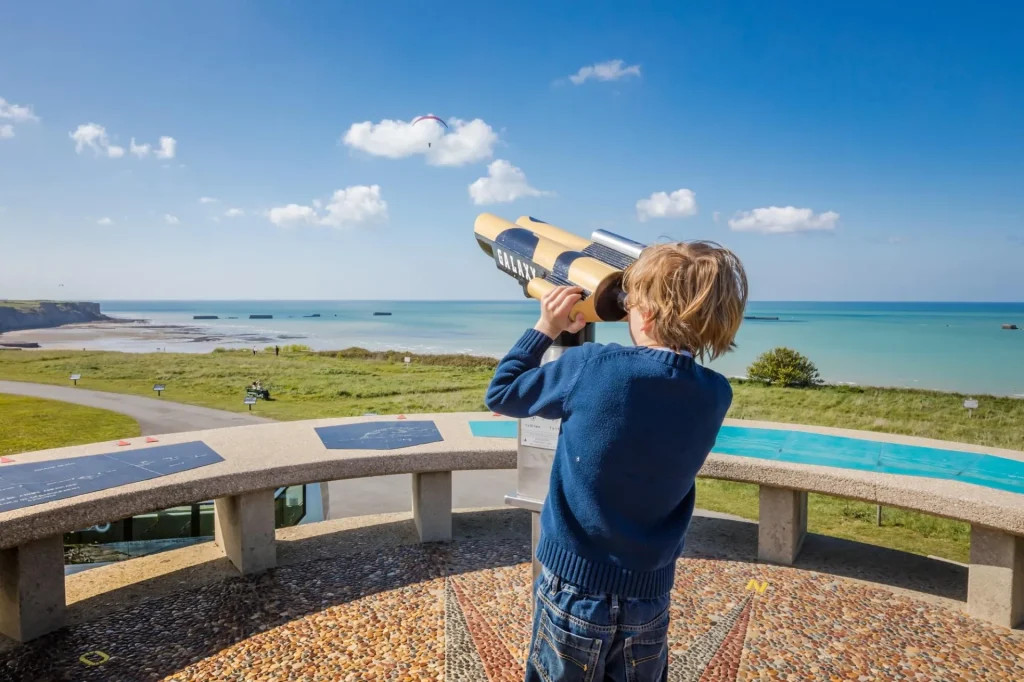 Arromanches Les Bains
Arromanches Les Bains
Exploring the historic Arromanches-les-Bains, a key site of the D-Day landings.
- Mont-Saint-Michel: This iconic tidal island and abbey is a UNESCO World Heritage site and one of France’s most recognizable landmarks. Visitors can explore the abbey, wander through the medieval streets, and enjoy the breathtaking views of the surrounding bay.
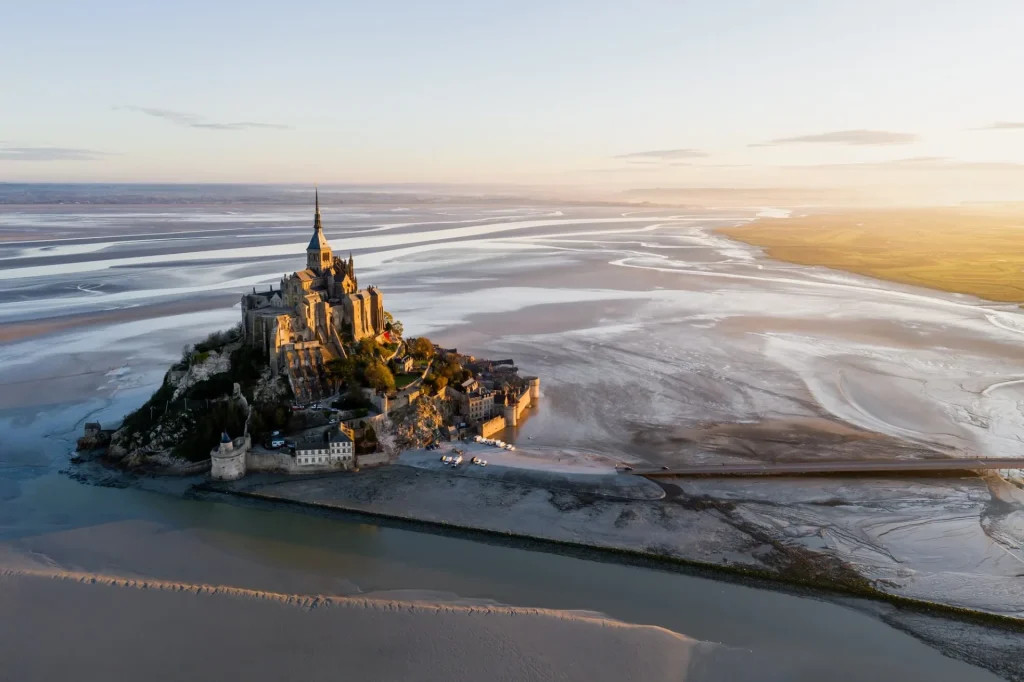 Mont Saint Michel en Normandie
Mont Saint Michel en Normandie
Discovering the breathtaking Mont Saint-Michel and its serene bay.
- Giverny (Claude Monet’s House and Gardens): The home and gardens of Impressionist painter Claude Monet are a major attraction, especially for art lovers. Visitors can stroll through the gardens that inspired Monet’s famous paintings, including the water lily pond and Japanese bridge.
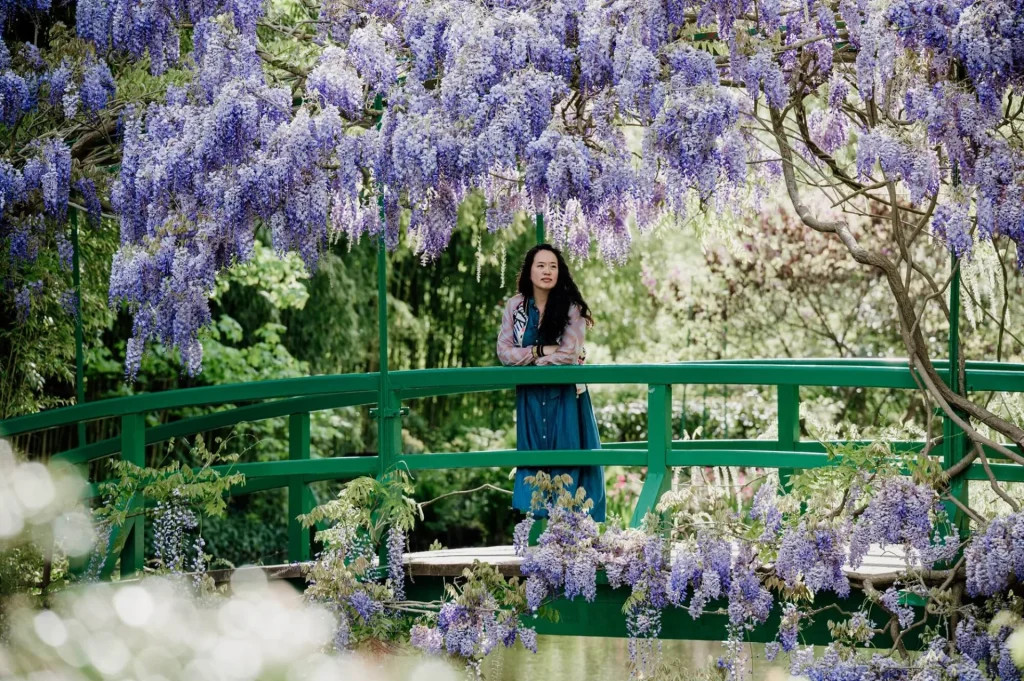 Jardins de Claude Monet à Giverny en Normandie
Jardins de Claude Monet à Giverny en Normandie
Wandering through the vibrant gardens of Claude Monet in Giverny.
- Bayeux Tapestry: This impressive embroidered cloth depicts the events leading up to the Norman conquest of England in 1066. It’s a valuable historical artifact and a must-see for those interested in medieval history.
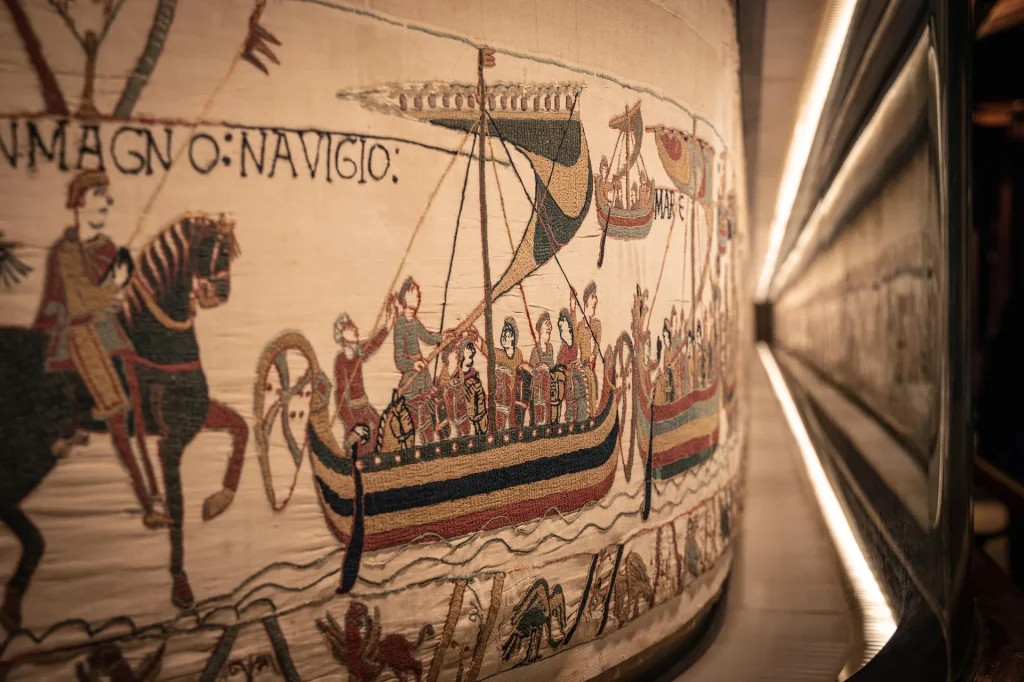 Tapisserie de Bayeux
Tapisserie de Bayeux
Admiring the intricate details of the historic Bayeux Tapestry.
- Rouen: The capital of Normandy, Rouen, is a historic city with stunning architecture, including the Rouen Cathedral (featured in Monet’s paintings) and the Place du Vieux Marché, where Joan of Arc was burned at the stake.
- Honfleur: A charming harbor town known for its picturesque waterfront, colorful buildings, and artistic heritage. It’s a great place to wander, enjoy fresh seafood, and soak up the atmosphere.
- Étretat: Famous for its dramatic cliffs and natural arches along the Alabaster Coast, Étretat is a popular destination for hiking and enjoying scenic views.
- Deauville: A chic seaside resort known for its beaches, casino, and horse racing. It’s a popular destination for those seeking a bit of glamour and relaxation.
- Normandy’s Food and Drink: Experience the region’s culinary delights, including cheese, cider, and seafood.
3. How Significant is War Tourism to Normandy’s Economy?
War tourism holds significant importance for Normandy’s economy, drawing millions of visitors annually to its historical sites and memorials. According to Normandie Tourisme, historical sites and memorials attracted over 5 million visitors in 2022, highlighting the economic impact of this sector.
- High Visitor Numbers: As mentioned earlier, over 5 million visitors were drawn to historical sites and memorials in 2022. The Normandy American Cemetery in Colleville-sur-Mer is particularly popular, drawing 1.7 million visitors each year.
- Economic Benefits: War tourism generates substantial revenue for local businesses, including hotels, restaurants, tour operators, and souvenir shops. The influx of tourists supports employment and contributes to the overall economic health of the region.
- Commemorative Events: Major commemorative events, such as the annual D-Day anniversary celebrations and the upcoming 80th anniversary in 2024, attract even larger numbers of visitors. These events provide a significant boost to the local economy.
- Infrastructure and Services: The need to accommodate war tourists has led to investments in infrastructure and services, including improved transportation, accommodation options, and visitor centers. These improvements benefit both tourists and local residents.
- Educational Impact: War tourism also plays a role in educating visitors about the events of World War II and promoting remembrance. This educational aspect adds value to the tourism experience and helps preserve the memory of those who fought and died in the region.
- Cultural Preservation: The preservation and maintenance of historical sites and memorials are supported by tourism revenue. This ensures that these important landmarks are preserved for future generations.
4. What are the Options for Experiential Tourism in Normandy?
Normandy offers a diverse range of experiential tourism options, catering to various interests and preferences. From interactive workshops and outdoor adventures to cultural immersions and culinary experiences, there’s something for everyone. Normandy Tourism promotes over 70 Normandy Experiences.
- Interactive Workshops: Engage in hands-on activities such as pressing your own organic apple juice, learning traditional crafts, or participating in a cooking class focused on Norman cuisine.
- Outdoor Adventures: Enjoy activities like dog sledding, rock pooling, hiking, cycling, and water sports. The Suisse Normande region is particularly popular for outdoor pursuits, with opportunities for canoeing, kayaking, and rock climbing.
- Historical Reenactments: Participate in historical reenactments that bring the past to life. Some events allow visitors to experience what life was like as a Viking or a medieval knight.
- Farm Stays: Experience rural life by staying on a working farm. This can include helping with chores, learning about agriculture, and enjoying fresh, locally sourced food.
- Gastronomic Tours: Embark on tours that focus on Normandy’s culinary heritage. This can include visiting local farms, cheese factories, cider producers, and seafood markets, as well as participating in tastings and cooking demonstrations.
- Cultural Immersion: Immerse yourself in Normandy’s culture by attending local festivals, visiting historical sites, and learning about the region’s traditions and customs.
- Spiritual Tourism: Explore Normandy’s religious heritage by visiting abbeys, churches, and other sacred sites. Participate in retreats or guided tours that focus on the region’s spiritual history.
5. How is Normandy Promoting Sustainable Tourism?
Normandy is actively promoting sustainable tourism to minimize its environmental impact and preserve its cultural heritage. This includes encouraging cycling tourism, promoting public transport, and supporting local tourism initiatives. Normandy Tourism provides resources for tourism professionals and businesses in their energy and social transition.
- Cycling Tourism: The region has invested in cycling infrastructure, including bike paths and rental services, to encourage visitors to explore Normandy by bicycle. This reduces reliance on cars and promotes a healthier, more environmentally friendly way to travel.
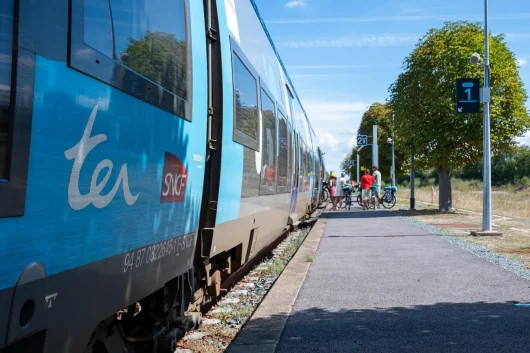 Cyclotouristes et train à quai en gare de Pontorson-Mont-Saint-Michel
Cyclotouristes et train à quai en gare de Pontorson-Mont-Saint-Michel
Cyclists and a train at Pontorson-Mont-Saint-Michel station, promoting eco-friendly tourism.
- Public Transport: Normandy Tourism promotes the use of public transport, such as trains and buses, to reduce carbon emissions and traffic congestion. They offer information on car-free getaways and routes that are easily accessible by public transport.
- Local Tourism: Encouraging visitors to explore local attractions, businesses, and services helps to support the regional economy and reduce the environmental impact associated with long-distance travel.
- Sustainable Accommodation: Promoting eco-friendly accommodation options, such as hotels and guesthouses that implement sustainable practices, helps to reduce the environmental footprint of the tourism sector.
- Carbon Footprint Reduction: Providing resources and support for tourism professionals and businesses to assess and reduce their carbon footprint helps to minimize the environmental impact of the industry.
- Virtual Tourism: Offering virtual tours and digital experiences allows visitors to explore Normandy from their homes, reducing the need for physical travel and associated emissions.
Eco-friendly bike accommodation at a campsite in Pont L’Évêque.
6. What Major Events are Scheduled for Tourism in Normandy?
Normandy hosts numerous major events throughout the year, attracting visitors and showcasing the region’s culture, history, and attractions. Significant events include the D-Day anniversary celebrations, festivals, and cultural exhibitions. Major events in Normandy include the D-Day commemorations, Normandy Impressionist Festival, and Medieval Festivals.
- D-Day Anniversary Celebrations: The annual D-Day anniversary celebrations in June are a major draw, attracting veterans, dignitaries, and visitors from around the world. The 80th anniversary in 2024 is expected to be particularly significant.
- Normandy Impressionist Festival: This festival celebrates Normandy’s Impressionist heritage with exhibitions, concerts, and cultural events throughout the region.
- Medieval Festivals: Several towns in Normandy host medieval festivals that recreate life in the Middle Ages with reenactments, markets, and entertainment.
- Horse Racing Events: Deauville hosts prestigious horse racing events that attract equestrian enthusiasts and visitors seeking a touch of glamour.
- Cider Route Festival: This festival celebrates Normandy’s cider-making traditions with tastings, tours, and cultural events along the Cider Route.
- Seafood Festivals: Coastal towns host seafood festivals that showcase the region’s fresh seafood and culinary traditions.
7. What are the Employment Opportunities in the Normandy Tourism Industry?
The Normandy tourism industry offers a wide range of employment opportunities, particularly in hospitality and catering. With 40,000 people employed annually, the industry is a significant contributor to the region’s economy. The Umih hospitality union reports 5000 unfilled positions throughout the region.
- Hospitality and Catering: There is high demand for housekeepers, wait staff, cooks, and other catering staff in hotels, restaurants, and other hospitality establishments.
- Tourism Services: Tour operators, visitor centers, and tourist attractions offer employment opportunities in customer service, guiding, and administration.
- Accommodation: Hotels, campsites, guesthouses, and rental properties require staff for management, maintenance, and guest services.
- Transportation: Transportation companies offer employment opportunities for drivers, tour guides, and support staff.
- Retail: Souvenir shops, boutiques, and markets offer employment opportunities in sales, customer service, and management.
- Skilled roles: Skilled professionals such as chefs, hotel managers and tour guides are constantly in high demand.
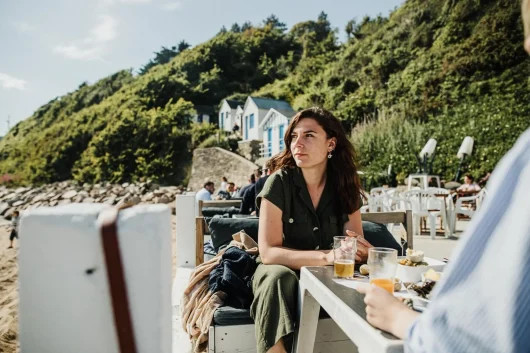 En terrasse au restaurant La Potiniere Barneville-Carteret
En terrasse au restaurant La Potiniere Barneville-Carteret
People enjoying outdoor dining at La Potiniere Restaurant, Barneville-Carteret.
8. What Business Opportunities Exist in Normandy Tourism?
Normandy tourism presents various business opportunities for entrepreneurs, ranging from accommodation and catering to tourism services and retail. AD Normandie, a regional development agency, can help fund projects.
- Accommodation: There is potential for new hotels, guesthouses, campsites, and rental properties, particularly those that cater to niche markets such as luxury or eco-friendly tourism.
- Catering: Opportunities exist for new restaurants, cafes, and food businesses that showcase Normandy’s culinary heritage and local products.
- Tourism Services: Tour operators, activity providers, and visitor centers can offer unique experiences and services to attract visitors.
- Retail: Souvenir shops, boutiques, and markets can cater to the needs of tourists with locally made products, crafts, and souvenirs.
- Niche Markets: There are opportunities to cater to niche markets such as war tourism, cultural tourism, adventure tourism, and sustainable tourism.
- Opening workshops: Businesses that want to open their workshops to visitors.
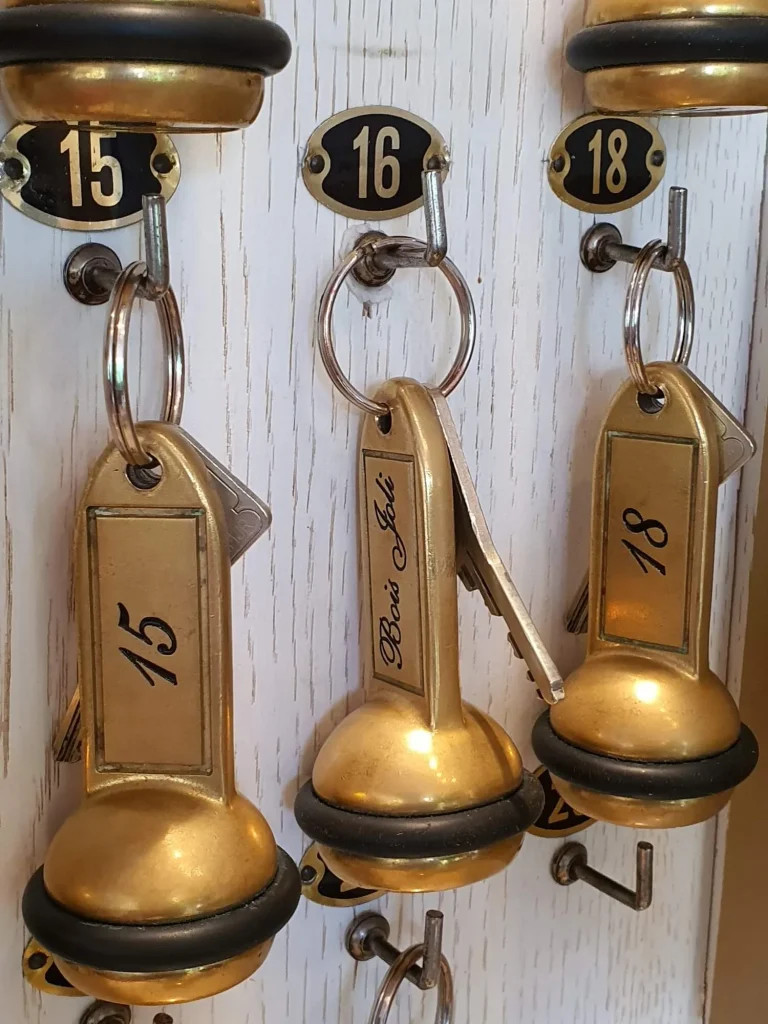 Bagnoles de l Orne le bois joli hotel restaurant
Bagnoles de l Orne le bois joli hotel restaurant
The charming Le Bois Joli Hotel Restaurant in Bagnoles de l’Orne.
9. What Tourism Courses are Available in Normandy?
Normandy offers a range of tourism courses at universities and colleges, designed to attract people to work in the industry and upskill employees. Normandy universities have designed several Master’s degrees in tourism engineering. All the courses include sustainable tourism modules.
- University Programs: Normandy universities offer Bachelor’s and Master’s degrees in tourism management, hospitality management, and related fields.
- Vocational Training: Colleges and vocational schools offer training programs in hospitality, catering, and tourism services.
- Specialized Courses: There are specialized courses available in areas such as sustainable tourism, cultural tourism, and event management.
- Online Courses: Some institutions offer online courses that allow students to study tourism-related subjects remotely.
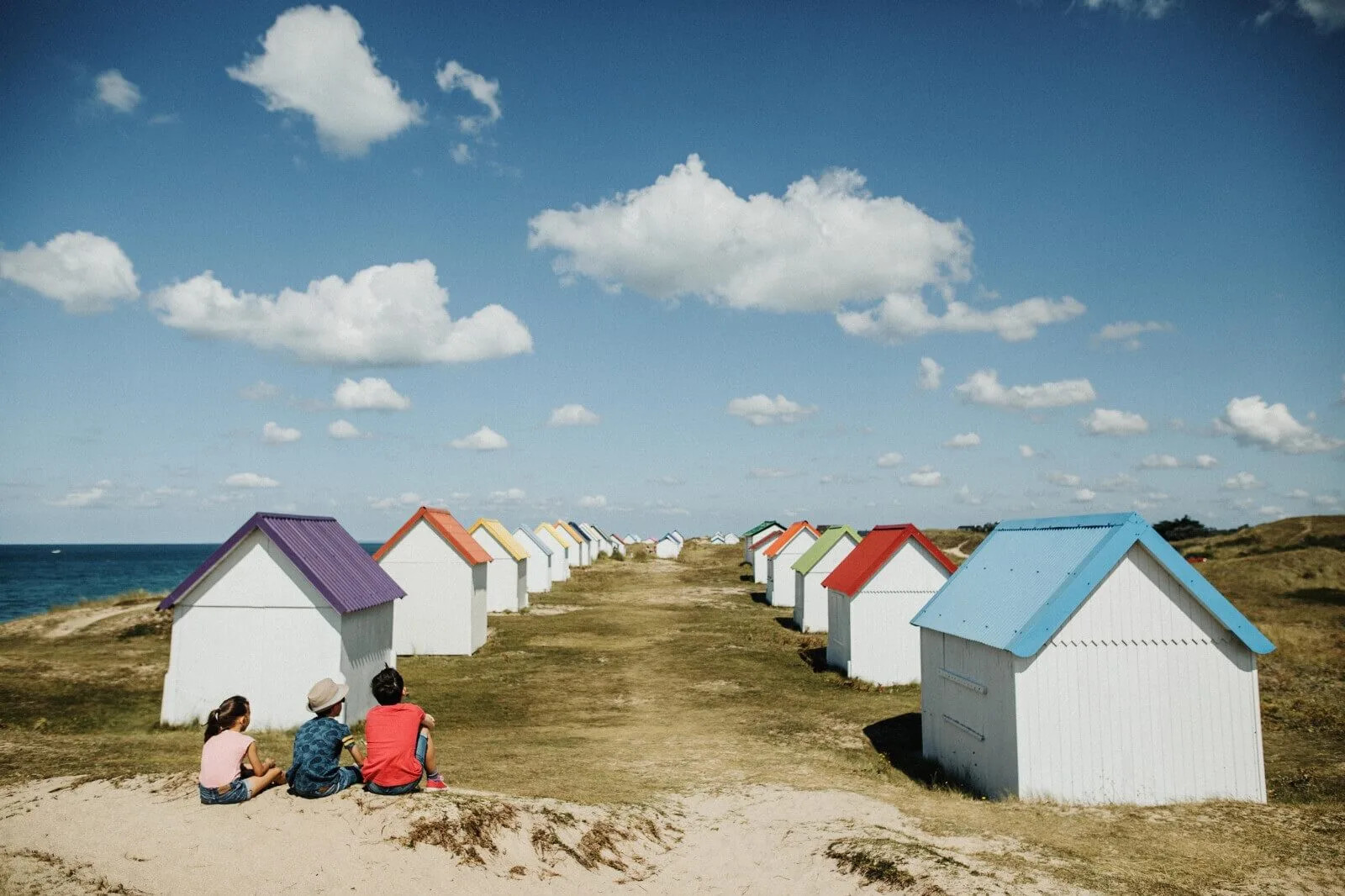 Cabines de plage de Gouville sur mer dans la Manche
Cabines de plage de Gouville sur mer dans la Manche
Colorful beach huts in Gouville-sur-Mer, La Manche.
10. What are Some Recent News and Developments in Normandy Tourism?
Recent news and developments in Normandy tourism include sustainability initiatives, restoration projects, and the promotion of local attractions. Examples include the restoration of Mont-Saint-Michel’s island nature and the promotion of local products such as cider.
- Sustainability Initiatives: Normandy is increasingly focused on sustainable tourism practices, with initiatives aimed at reducing the environmental impact of the industry and promoting responsible travel.
- Restoration Projects: Projects such as the restoration of Mont-Saint-Michel’s island nature aim to preserve the region’s cultural heritage and enhance its appeal to visitors.
- Promotion of Local Products: Efforts to promote local products such as cider, cheese, and seafood help to support the regional economy and showcase Normandy’s culinary heritage.
- New Attractions and Experiences: New attractions and experiences, such as the AJ Hackett bungee jumping site in Souleuvre, add to the region’s appeal and attract new visitors.
- Commemorative Events: The upcoming 80th anniversary of D-Day in 2024 is expected to be a major event that will draw significant attention to Normandy and its history.
11. What are the Accommodation Options in Normandy?
Normandy offers a diverse range of accommodation options to suit different preferences and budgets. According to official statistics, guest accommodation accounts for 3/4 of tourist expenditure in Normandy, highlighting its importance. Here’s a detailed breakdown of the options:
- Hotels: Normandy boasts a wide variety of hotels, ranging from budget-friendly options to luxurious 5-star establishments. Major cities like Rouen and Caen, as well as popular coastal resorts such as Deauville and Honfleur, offer a range of hotels with different amenities and price points.
- Boutique Hotels: For a more intimate and unique experience, boutique hotels are available, often located in historic buildings or charming villages. These hotels provide personalized service and a distinctive atmosphere.
- Bed and Breakfasts (Chambres d’hôtes): B&Bs are a popular choice for those seeking a cozy and authentic stay. These accommodations often offer a more personal touch, with hosts providing local insights and home-cooked breakfasts.
- Gîtes (Holiday Homes): Gîtes are self-catering holiday homes that range from small apartments to large country houses. They are ideal for families or groups who prefer the flexibility of having their own space and cooking facilities.
- Campsites: Normandy has numerous campsites, catering to both tent campers and those with caravans or motorhomes. These sites offer a range of facilities, from basic amenities to swimming pools and entertainment.
- Rental Properties: Platforms like Airbnb and VRBO offer a wide selection of apartments, houses, and villas for rent. This option is suitable for travelers looking for a home-away-from-home experience.
- Farm Stays: For a unique and immersive experience, farm stays offer the opportunity to stay on a working farm, participate in agricultural activities, and enjoy fresh, locally sourced food.
- Eco-Friendly Accommodation: In line with Normandy’s sustainable tourism efforts, eco-friendly accommodations are becoming increasingly popular. These establishments implement practices such as energy conservation, waste reduction, and the use of sustainable materials.
12. What is the Culinary Scene Like in Normandy?
Normandy is renowned for its rich culinary traditions and high-quality local products. Norman chefs are celebrated for their expertise in showcasing local flavors, making it a must-visit destination for food lovers. Key aspects of the culinary scene include:
- Michelin-Starred Restaurants: Normandy boasts 20 Michelin-starred restaurants, offering exquisite dining experiences that highlight the region’s gastronomy. These establishments use fresh, local ingredients to create innovative and refined dishes.
- Local Eateries: In addition to Michelin-starred restaurants, Normandy has a wide range of good eateries (80,000 in total) to suit any budget. These include traditional bistros, seafood restaurants, and charming cafes that serve authentic Norman cuisine.
- Cheese: Normandy is famous for its creamy cheeses, including Camembert, Pont-l’Évêque, Livarot, and Neufchâtel. These cheeses are often enjoyed on their own, with bread and cider, or used in regional dishes.
- Seafood: With its extensive coastline, Normandy offers an abundance of fresh seafood. Popular dishes include moules marinières (mussels cooked in white wine), oysters, scallops, and various types of fish.
- Cider and Calvados: Normandy is known for its apple orchards and cider production. Cider is a refreshing drink that pairs well with many local dishes, while Calvados, an apple brandy, is a popular digestif.
- Regional Dishes: Traditional Norman dishes include tripes à la mode de Caen (tripe cooked in cider), teurgoule (a rice pudding baked with milk and cinnamon), and tarte Normande (apple tart).
- Local Markets: Visiting local markets is a great way to experience Normandy’s culinary scene. These markets offer a variety of fresh produce, cheeses, meats, and other local products.
- Gastronomic Tours: Food tours and culinary experiences provide opportunities to learn about Normandy’s gastronomy, visit local farms and producers, and participate in tastings and cooking demonstrations.
13. What is the Best Time of Year to Visit Normandy?
The best time to visit Normandy depends on your preferences and interests. Each season offers a unique experience, with different weather conditions, events, and attractions. The general consensus is that late spring and early autumn offer the most pleasant weather and fewer crowds. Here’s a seasonal breakdown:
- Spring (April-May): Spring is a beautiful time to visit Normandy, with mild temperatures, blooming flowers, and fewer crowds than the summer months. It’s a great time for exploring gardens, historical sites, and coastal areas.
- Summer (June-August): Summer is the peak tourist season in Normandy, with warm weather and long days. The D-Day anniversary celebrations in June attract large numbers of visitors. Beaches are popular during this time, and many outdoor events and festivals take place.
- Autumn (September-October): Autumn is another excellent time to visit Normandy, with pleasant temperatures, fewer crowds, and beautiful fall foliage. It’s a great time for hiking, cycling, and exploring the countryside. The apple harvest season also takes place in the fall, with cider festivals and other related events.
- Winter (November-March): Winter is the off-season in Normandy, with colder temperatures and fewer daylight hours. However, it can still be a good time to visit for those seeking a quiet and peaceful experience. Some attractions may have reduced hours or be closed altogether. The Christmas markets in December can be a festive draw.
14. How Easy is it to Get Around Normandy?
Getting around Normandy is relatively easy, with various transportation options available to suit different needs and preferences. Each mode of transport has its advantages and can enhance your travel experience depending on your itinerary. Here are the main ways to get around:
- Car: Renting a car is the most flexible way to explore Normandy, allowing you to visit remote areas and travel at your own pace. Major car rental companies operate at airports and in major cities.
- Train: Normandy has a good rail network, with trains connecting major cities and towns. The SNCF (French National Railway Company) operates the trains. Traveling by train is a convenient way to reach destinations such as Rouen, Caen, and Bayeux.
- Bus: Bus services connect smaller towns and villages that are not accessible by train. Regional bus networks provide affordable transportation, but schedules may be less frequent than trains.
- Bicycle: Cycling is a popular way to explore Normandy, particularly in rural areas and along the coast. Many towns offer bike rental services, and there are numerous cycling routes to choose from.
- Ferry: Ferries connect Normandy to England and other destinations across the English Channel. Ferry services operate from ports such as Cherbourg, Caen (Ouistreham), and Dieppe.
- Taxis and Ride-Sharing: Taxis are available in major cities and towns, but they can be expensive. Ride-sharing services like Uber may also operate in some areas.
15. What are Some Travel Tips for Visiting Normandy?
To make the most of your trip to Normandy, consider these travel tips. These tips cover various aspects of travel, from planning and packing to local customs and safety.
- Plan Ahead: Book accommodation, tours, and transportation in advance, especially during peak season.
- Learn Some French: While many people in tourist areas speak English, knowing some basic French phrases will enhance your experience and be appreciated by locals.
- Pack Appropriately: The weather in Normandy can be unpredictable, so pack layers of clothing and be prepared for rain. Comfortable walking shoes are essential for exploring historical sites and coastal areas.
- Try the Local Cuisine: Sample Normandy’s culinary delights, including cheese, cider, seafood, and regional dishes.
- Visit Local Markets: Explore local markets for fresh produce, local products, and a taste of Norman culture.
- Respect Local Customs: Be aware of local customs and etiquette, such as greeting people with a “bonjour” and respecting religious sites.
- Stay Safe: Be aware of your surroundings and take precautions against pickpocketing, especially in crowded areas. Keep valuables secure and avoid walking alone in poorly lit areas at night.
- Check for Events: Check the local event calendar for festivals, concerts, and other events that may be of interest.
- Use Reliable Information: Use reputable sources for travel information, such as official tourism websites, guidebooks, and travel blogs.
- Be Prepared for Driving: If renting a car, be aware of French driving laws and customs. Familiarize yourself with road signs and speed limits.
16. What are Some Day Trip Options from Normandy?
Normandy’s central location makes it a great base for exploring other regions of France. These day trips offer a diverse range of experiences, from historical sites and cultural landmarks to natural beauty and charming villages. Here are some popular day trip options:
- Paris: The French capital is easily accessible from Normandy by train or car. Spend a day exploring iconic landmarks such as the Eiffel Tower, Louvre Museum, and Notre-Dame Cathedral.
- Brittany: The neighboring region of Brittany is known for its rugged coastline, historic towns, and Celtic heritage. Visit destinations such as Saint-Malo, Dinan, and Mont-Saint-Michel (which is technically in Normandy but close to the Brittany border).
- Loire Valley: The Loire Valley is famous for its châteaux, vineyards, and picturesque landscapes. Visit iconic châteaux such as Chambord, Chenonceau, and Villandry.
- Chartres: The city of Chartres is home to a magnificent Gothic cathedral, a UNESCO World Heritage site. Explore the cathedral’s stunning stained glass windows and intricate architecture.
- Giverny: If you haven’t already visited, Giverny is a short trip from many parts of Normandy and is home to Claude Monet’s house and gardens. Explore the gardens that inspired Monet’s famous paintings.
- Dieppe: This charming coastal town is known for its fishing port, seafood restaurants, and Saturday market. Explore the town’s historic center and enjoy fresh seafood by the harbor.
17. How Does SIXT.VN Enhance the Normandy Tourism Experience?
SIXT.VN offers a range of services that enhance the Normandy tourism experience, providing travelers with convenient and reliable solutions for their travel needs. SIXT.VN offers comprehensive services, including travel assistance, and thorough planning support. By leveraging SIXT.VN’s services, visitors can enjoy a seamless and stress-free exploration of Normandy’s rich heritage, stunning landscapes, and vibrant culture.
- Airport Transfers: SIXT.VN provides airport transfer services, ensuring a smooth and hassle-free arrival and departure experience.
- Hotel Bookings: SIXT.VN offers a wide range of hotel options to suit different preferences and budgets, making it easy to find the perfect accommodation in Normandy.
- Tour Packages: SIXT.VN offers curated tour packages that showcase the best of Normandy, including historical sites, cultural attractions, and culinary experiences.
- Travel Assistance: SIXT.VN provides travel assistance and support to help travelers plan their trip, answer questions, and resolve any issues that may arise.
- Local Insights: SIXT.VN offers local insights and recommendations to help travelers discover hidden gems and authentic experiences in Normandy.
- Booking Flexibility: SIXT.VN understands that travel plans can change, offering flexible booking options that allow travelers to adjust their itinerary as needed.
18. How Can I Book Services with SIXT.VN for My Trip to Normandy?
Booking services with SIXT.VN for your trip to Normandy is easy and convenient. SIXT.VN offers multiple channels for booking, including online, by phone, and in person, ensuring a seamless and user-friendly experience for travelers. Whether you prefer the convenience of online booking or the personalized assistance of a phone call, SIXT.VN makes it simple to arrange your travel services and plan your perfect trip to Normandy.
- Online Booking: Visit the SIXT.VN website and browse the available services, including airport transfers, hotel bookings, and tour packages. Select the services you need and follow the online booking process.
- Phone Booking: Call the SIXT.VN hotline to speak with a travel agent who can help you plan your trip and book your services over the phone.
- In-Person Booking: Visit a SIXT.VN office to book your services in person and receive personalized assistance from a travel expert.
- Mobile App: Download the SIXT.VN mobile app to book your services on the go and manage your travel itinerary from your smartphone.
19. What Are Some Common Misconceptions About Normandy Tourism?
Several misconceptions about Normandy tourism can deter potential visitors or lead to inaccurate expectations. Addressing these misconceptions can help travelers better appreciate what Normandy has to offer and plan their trip accordingly.
- It’s Just About the D-Day Beaches: While the D-Day beaches are a major draw, Normandy offers much more, including stunning landscapes, cultural attractions, and culinary experiences.
- It’s Always Raining: While Normandy can experience rainy weather, particularly in the fall and winter, it also has many sunny days, especially in the spring and summer.
- It’s Too Expensive: Normandy offers accommodation and dining options to suit different budgets, from budget-friendly guesthouses to luxury hotels and Michelin-starred restaurants.
- It’s Difficult to Get Around Without a Car: While renting a car offers flexibility, it’s possible to explore Normandy using public transport, particularly in major cities and towns.
- It’s Only for History Buffs: While Normandy has a rich history, it also offers attractions and activities for people of all interests, including art lovers, foodies, and outdoor enthusiasts.
- The Locals Only Speak French: While French is the official language, many people in tourist areas speak English, making it relatively easy for English-speaking visitors to communicate.
20. What are Some Hidden Gems to Discover in Normandy?
While Normandy’s main attractions are well-known, the region is also home to numerous hidden gems that offer unique and authentic experiences. These off-the-beaten-path destinations provide a glimpse into Normandy’s local culture, natural beauty, and rich history.
- Suisse Normande: This region of rolling hills and lush landscapes offers opportunities for hiking, canoeing, and rock climbing. It’s a great destination for outdoor enthusiasts seeking a break from the coast.
- Le Bec-Hellouin: This charming village is home to a beautiful abbey, one of the most important monastic sites in Normandy. Explore the abbey’s architecture, gardens, and religious artifacts.
- Villedieu-les-Poêles: This town is known for its copper workshops, where artisans create handmade copper pots, pans, and other items. Visit the workshops to see the artisans at work and purchase unique souvenirs.
- Barfleur: This picturesque fishing port is one of the oldest in Normandy, with a rich maritime history. Explore the harbor, visit the local church, and enjoy fresh seafood at one of the town’s restaurants.
- Château de Crèvecoeur: This medieval castle has been carefully restored and offers a glimpse into life in Normandy during the Middle Ages. Explore the castle’s ramparts, towers, and gardens.
- Étretat Gardens: While Étretat is famous for its cliffs, the Étretat Gardens offer a unique and artistic experience. These gardens feature sculptures, installations, and stunning views of the coastline.
- Saint-Céneri-le-Gérei: This charming village is considered one of the most beautiful in France, with its stone houses, flower-filled gardens, and tranquil atmosphere.
- The D-Day Landing Beaches offer a quieter, more reflective experience, especially outside the peak summer months.
Address: 260 Cau Giay, Hanoi, Vietnam. Hotline/Whatsapp: +84 986 244 358. Website: SIXT.VN.
FAQ about Normandy Tourism
Q1: What is the best way to get to Normandy from Paris?
The best way to get to Normandy from Paris is by train, which takes about 2-3 hours to reach major cities like Rouen and Caen.
Q2: What are the must-see historical sites in Normandy?
Must-see historical sites in Normandy include the D-Day beaches, the Normandy American Cemetery, and the Caen Memorial.
Q3: Is Normandy a good destination for families with children?
Yes, Normandy is a great destination for families, offering historical sites, beaches, and outdoor activities suitable for children of all ages.
Q4: What local foods should I try in Normandy?
You should definitely try Camembert cheese, cider, seafood, and tarte Normande while in Normandy.
Q5: How can I explore Normandy without a car?
You can explore Normandy using a combination of trains and buses, which connect major cities and towns. Cycling is also a popular option in rural areas.
Q6: What is the best time of year to visit Normandy for good weather?
The best time to visit Normandy for good weather is in the late spring (April-May) or early autumn (September-October).
Q7: Are there guided tours available for the D-Day beaches?
Yes, there are many guided tours available for the D-Day beaches, offering detailed historical insights and information.
Q8: What are some free activities to do in Normandy?
Free activities in Normandy include visiting beaches, exploring local markets, and hiking in the countryside.
Q9: How far in advance should I book accommodation in Normandy?
It is recommended to book accommodation in Normandy well in advance, especially during peak season (summer months).
Q10: What are the sustainable tourism options in Normandy?
Sustainable tourism options in Normandy include cycling, using public transport, staying in eco-friendly accommodations, and supporting local businesses.
Are you ready to explore Normandy? Let SIXT.VN help you plan your perfect trip. Contact us today to learn more about our tour packages, airport transfers, and hotel booking services.



